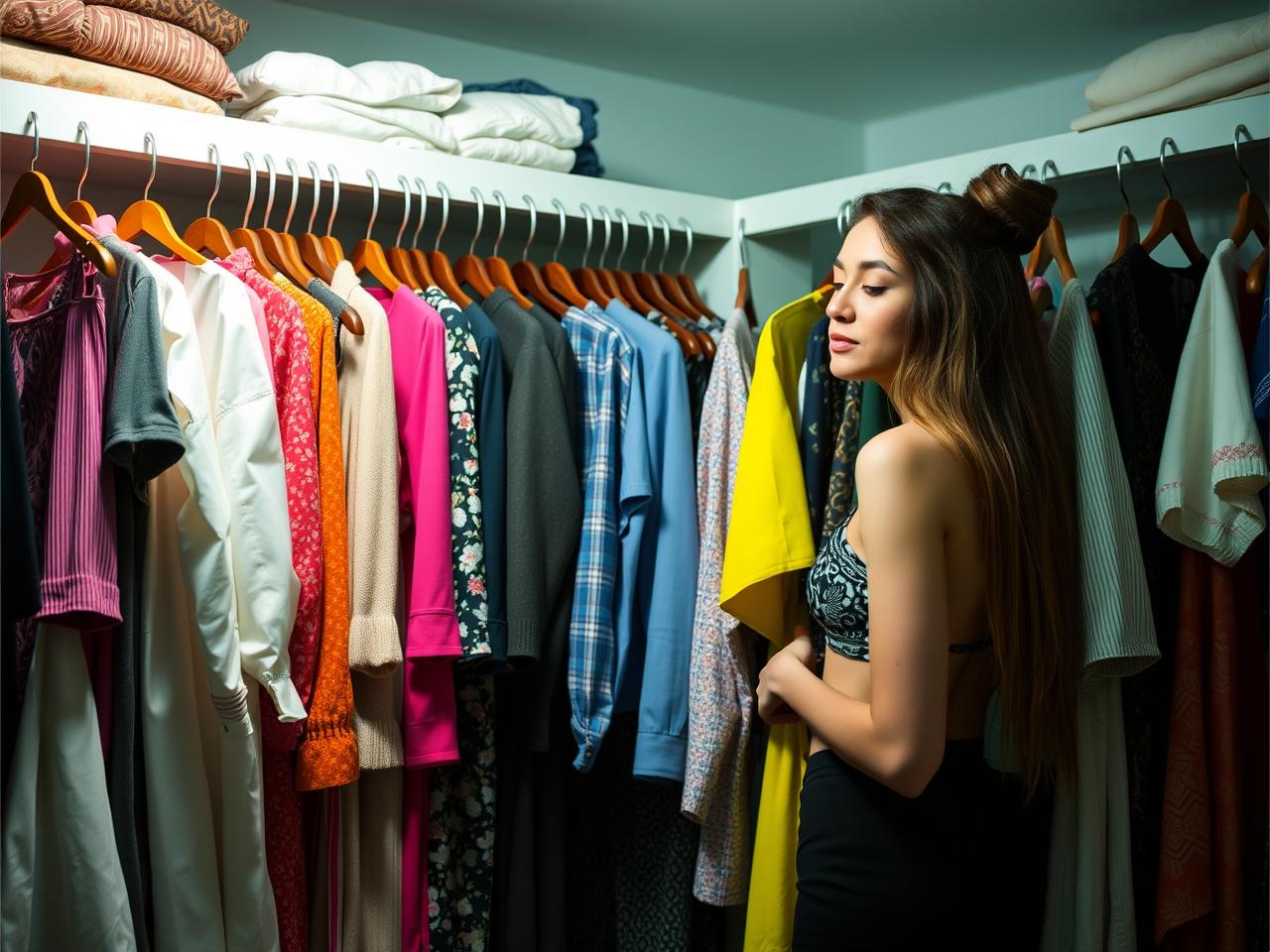The Real Reason Your Closet is Full of Clothes but You Have Nothing to Wear
The “nothing to wear” phenomenon is a common experience for many individuals, despite having a closet full of clothing. This paradox can be attributed to several factors. Firstly, the accumulation of clothing over time often leads to cluttered and disorganized closets, making it difficult to locate and access desired items.
This overabundance can create a sense of overwhelm and hinder the ability to make efficient clothing choices. Secondly, impulsive purchasing habits contribute to this issue. Many people buy clothes without considering their existing wardrobe or personal style, resulting in a collection of mismatched items that don’t coordinate well.
This lack of cohesion can make it challenging to create satisfying outfits, even with numerous clothing options available. Furthermore, the tendency to retain outdated or ill-fitting clothing exacerbates the problem. Keeping items that no longer suit one’s body or current fashion preferences can clutter the wardrobe and create a false sense of abundance without providing practical options.
Understanding these underlying causes can help individuals address the “nothing to wear” dilemma and develop strategies for creating a more functional and satisfying wardrobe.
Key Takeaways
- The Closet Conundrum: You have nothing to wear because you lack a cohesive wardrobe strategy.
- The Impulse Buy Trap: Your closet is a black hole for clothes due to impulsive shopping habits.
- The “I’ll Fit into This Someday” Syndrome: Your overflowing closet is a result of holding onto clothes for unrealistic reasons.
- The Fashion FOMO: You keep buying clothes you never wear due to fear of missing out on trends.
- The Comfort Zone Conundrum: You always reach for the same outfit because of a lack of variety and experimentation in your wardrobe.
- The Emotional Attachment Trap: Difficulty letting go of clothes you never wear is due to emotional attachment.
- The Closet Cleanse: Declutter and have something to wear by organizing, donating, and creating a versatile wardrobe.
The Impulse Buy Trap: How Your Closet Became a Black Hole for Clothes

The Consequences of Impulse Buying
This can create a sense of overwhelm, making it difficult to put together outfits that make us feel confident and comfortable. The rise of fast fashion has only exacerbated the problem, making it easier to fall into the impulse buy trap. With new trends and affordable clothing options constantly emerging, it’s tempting to make frequent purchases without considering their long-term value to our wardrobe.
The Result: A Closet Full of Unloved Items
As a result, our closets can become cluttered with items we rarely wear or don’t truly love. Recognizing the impact of impulse buying on our closets is the first step towards creating a more intentional and functional wardrobe.
Towards a More Intentional Wardrobe
By acknowledging the impulse buy trap, we can begin to make more thoughtful purchasing decisions, curating a wardrobe that reflects our personal style and meets our needs.
The “I’ll Fit into This Someday” Syndrome: The Real Reason Your Closet is Overflowing

One common reason for an overflowing closet is the “I’ll fit into this someday” syndrome. Many of us hold onto clothes that no longer fit in the hopes that we will be able to wear them again in the future. This can lead to a significant amount of space being taken up by items that we are not currently able to enjoy or make use of.
Additionally, this mindset can contribute to feelings of guilt or frustration when we see these unworn items in our closet, further adding to the sense of having nothing to wear. Another factor that contributes to an overflowing closet is sentimental attachment. We may hold onto clothes for emotional reasons, such as items worn during significant events or gifted by loved ones.
While these items hold sentimental value, they may not necessarily align with our current style or needs, leading to a cluttered and overwhelming closet. Understanding these underlying reasons for an overflowing closet can help us make more mindful decisions about what we choose to keep and let go of.
The Fashion FOMO: Why You Keep Buying Clothes You Never Wear
The fear of missing out (FOMO) is a powerful force that can influence our shopping habits and contribute to the accumulation of unworn clothes in our closets. With the constant stream of new trends and styles showcased on social media and in stores, it’s easy to feel like we need to keep up with the latest fashion in order to feel stylish and relevant. This can lead to impulse purchases and a closet filled with items that we never actually wear.
Additionally, the pressure to have a varied and Instagram-worthy wardrobe can lead us to buy clothes for specific occasions or trends, even if they don’t truly align with our personal style or lifestyle. This can result in a closet full of clothes that don’t work well together or don’t reflect our authentic selves, contributing to the feeling of having nothing to wear. Overcoming fashion FOMO involves reevaluating our priorities and focusing on building a wardrobe that truly reflects who we are and what makes us feel confident and comfortable.
The Comfort Zone Conundrum: Why You Always Reach for the Same Outfit
Many people find themselves reaching for the same outfit day after day, despite having a closet full of clothes. This comfort zone conundrum can stem from various factors, including habit, convenience, and confidence. When we find an outfit that we feel comfortable and confident in, it’s natural to want to reach for it repeatedly.
This can lead to neglecting other items in our closet and perpetuating the feeling of having nothing to wear. Furthermore, the convenience of having a go-to outfit can make it easy to overlook other options in our closet. When we’re pressed for time or feeling indecisive, it’s tempting to stick with what we know works well rather than exploring new combinations or styles.
This can result in a lack of variety in our wardrobe and contribute to the feeling of outfit fatigue. By understanding the comfort zone conundrum, we can take steps to break out of our style rut and explore new ways of expressing ourselves through clothing.
The Emotional Attachment Trap: Letting Go of Clothes You Never Wear

Sentimental Connections Hold Us Back
Emotional attachment is a common reason why many people struggle to let go of clothes they never wear. Whether it’s an item worn during a significant event or a gift from a loved one, these sentimental connections can make it challenging to part with unworn clothes. However, holding onto these items can contribute to an overflowing closet and make it difficult to see and access the clothes we truly love and enjoy wearing.
Emotional Barriers to Letting Go
Additionally, there may be emotional barriers such as guilt or nostalgia that prevent us from letting go of unworn clothes. We may feel guilty about getting rid of items that were expensive or gifted to us, or nostalgic about pieces that remind us of past experiences.
Breaking Free from Emotional Attachment
Overcoming the emotional attachment trap involves acknowledging these feelings and reassessing the value that these items bring to our lives. By letting go of clothes that no longer serve us, we can create space for new opportunities and experiences in both our wardrobe and our lives.
The Closet Cleanse: How to Declutter and Actually Have Something to Wear
The key to overcoming the “nothing to wear” conundrum is through a thorough closet cleanse. By decluttering our wardrobes and making intentional choices about what we keep, we can create a more functional and enjoyable space for getting dressed each day. Start by taking everything out of your closet and assessing each item individually.
Consider whether it fits your current style, lifestyle, and body shape, as well as whether it brings you joy and confidence when worn. As you go through your clothes, create separate piles for items to keep, donate, sell, or discard. Be honest with yourself about which items you truly love and wear regularly, and which ones are simply taking up space.
Letting go of unworn or unloved clothes can be liberating and create space for new possibilities in your wardrobe. Once you’ve decluttered your closet, take the time to organize your remaining items in a way that makes it easy to see and access everything you have. Consider using storage solutions such as bins, hangers, and shelves to keep your clothes tidy and visible.
In addition to decluttering your closet, consider implementing shopping habits that align with your values and needs. Instead of making impulse buys based on trends or sales, take the time to consider whether an item truly fits into your wardrobe and brings you joy and confidence when worn. Focus on building a versatile and cohesive wardrobe that reflects your authentic self and makes getting dressed each day an enjoyable experience.
By taking these steps towards a more intentional approach to your wardrobe, you can declutter your closet and actually have something to wear.
FAQs
What is the real reason why my closet is full of clothes but I have nothing to wear?
The real reason your closet is full of clothes but you have nothing to wear is likely due to a combination of factors such as impulse buying, trends, and emotional attachment to clothing items.
How does impulse buying contribute to a full closet with nothing to wear?
Impulse buying often leads to purchasing clothing items that do not necessarily fit with your personal style or wardrobe needs, resulting in a closet full of clothes that do not work well together.
What role do trends play in contributing to a full closet with nothing to wear?
Following trends can lead to purchasing items that quickly go out of style, adding to the clutter in your closet and making it difficult to create cohesive outfits.
How does emotional attachment to clothing items impact the issue of having nothing to wear?
Emotional attachment to clothing items can make it difficult to let go of pieces that no longer serve a purpose in your wardrobe, leading to a cluttered closet and difficulty in finding outfits that you feel good in.
What are some strategies for addressing a full closet with nothing to wear?
Strategies for addressing a full closet with nothing to wear include decluttering and organizing your wardrobe, identifying your personal style, and being more mindful of your purchasing habits to avoid impulse buying.







